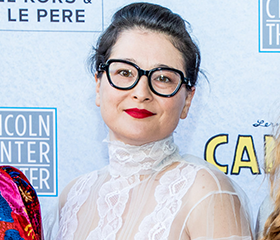How do you create the costumes for Camelot? If you’re Jennifer Moeller, who designed what the characters wear in the current revival, the road begins in New Haven. “I can trace my path all the way back to my days as a graduate student at Yale,” she told me the other day. “I worked on a production of Shakespeare’s King John. It was a modernized take on the medieval, which in many ways corresponds what we did with Camelot.”
King John for Moeller led to a costume-design assignment on Richard III, at the Shakespeare Theater Company, in Washington, D.C. “I cut my teeth there,” Moeller said. “I worked on 14 productions and learned a lot but I reached a point where I said, ‘Okay, I’m done.’” Retaining her base in theater, Moeller branched out to film and TV, including the recent Apple TV series Dickinson. But when it came time to begin work on Camelot, Moeller said, “The first thing I did was look at research from my early Shakespeare days. In fact, one of Lancelot’s looks is reminiscent of something from the Yale King John.”
Moeller and I discussed Lancelot’s striking fight-tournament costume of quilted-blue tunic and silver-leather breastplate, but mostly we chatted about the dozen or so looks she created for Guinevere. Referring to the informal name of Phillipa Soo, who plays the role, Moeller said, “Pippa really knows how to rock a train.”
Especially when Soo is wearing a crimson-velvet gown, one of the production’s most resplendent. “I looked at a lot of Valentino while thinking about Camelot,” Moeller said. “That was inspiring. Nobody does red like he does.”
If a few luminaries like Valentino provided the inspiration, the perspiration involved in making the approximately 125 costumes worn by the show’s regular actors resulted from the toil of many people in many places. Moeller mentioned a costume shop in New York’s Garment District that made many of Camelot’s creations and a tailor in Hungary who worked on the many of the men’s costumes. (The show’s armor was made in Ukraine.) And she mentioned Lavonne “Lonnie” Richards, a New York-based tailor with whom Moeller worked on Dickinson.
“I get Lonnie and Lonnie gets me,” Moeller said. “She’s an incredible talent who does mostly film and TV so I feel so fortunate when she works with me on theater projects.” One example of Richards’ Camelot finesse involved that red-velvet Guinevere gown. “It looks clean and simple,” Moeller explained, “but underneath it’s very complicated. There’s a corset and very complex seams. Lonnie sewed the seams by hand. She has an incredible sense of craft.”
Moeller also oozes craft. In our computer age when fewer and fewer clothing and costume designers sweat over a sketchpad, she does all her own drawing and painting. Such talents had an early gestation. With her Korean grandmother (Moeller’s father is Caucasian-American, her mother a Korean immigrant), she did an assortment of crafts. Similar learning took place with her paternal grandmother, who lived in southern Vermont. “She taught me a lot about basic sewing and about details,” Moeller said. “Enough to tickle the urge.”
If the current Beaumont production beautifully reflects the specific, when I asked Moeller to name her general goal for the evening she is clear and basic: “When an audience looks at this show I want them to feel that they’re in Camelot.”
Brendan Lemon is a freelance journalist in New York.
